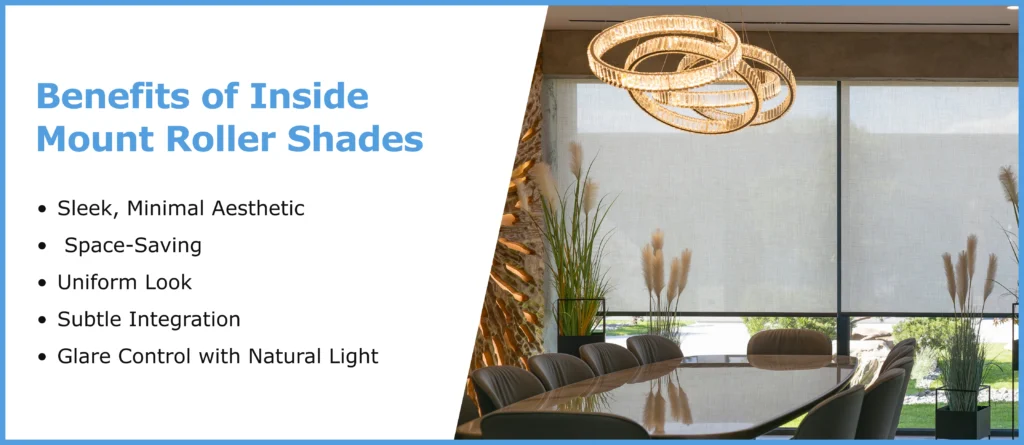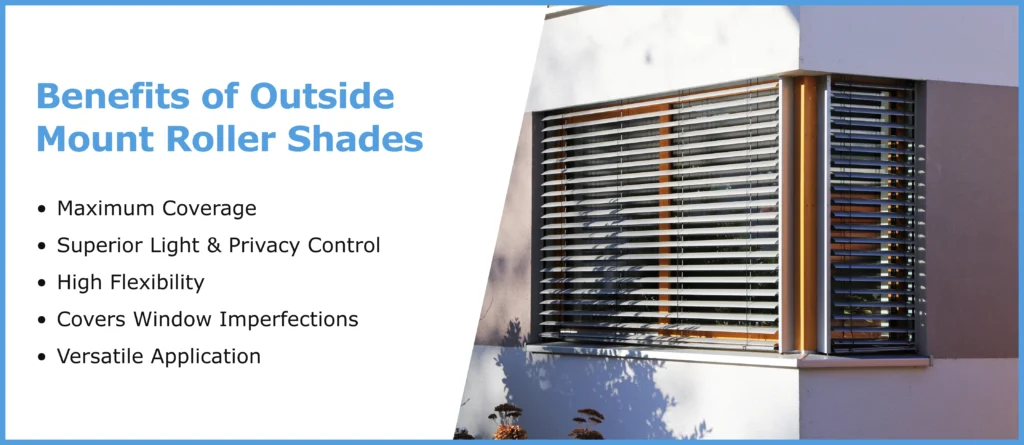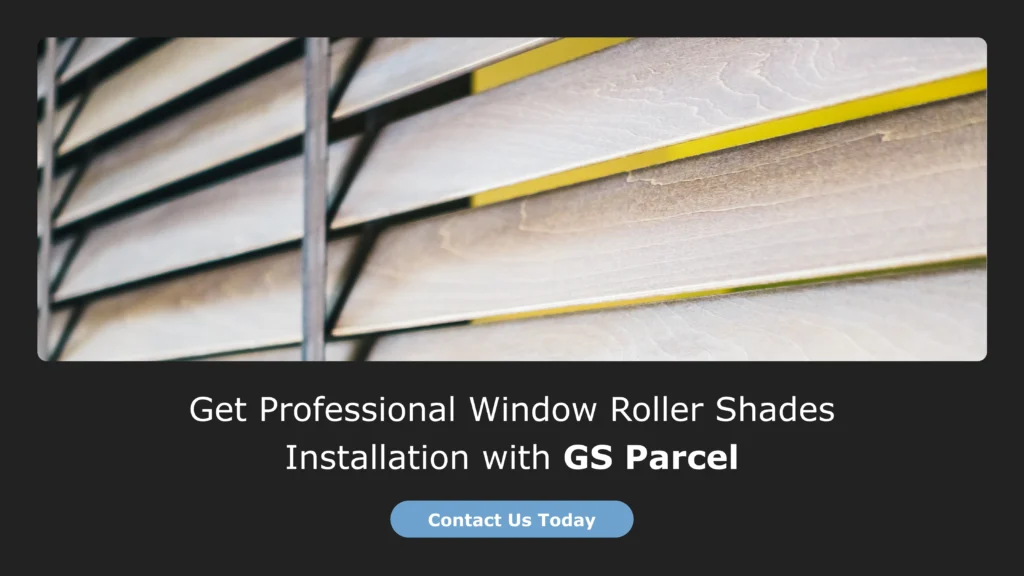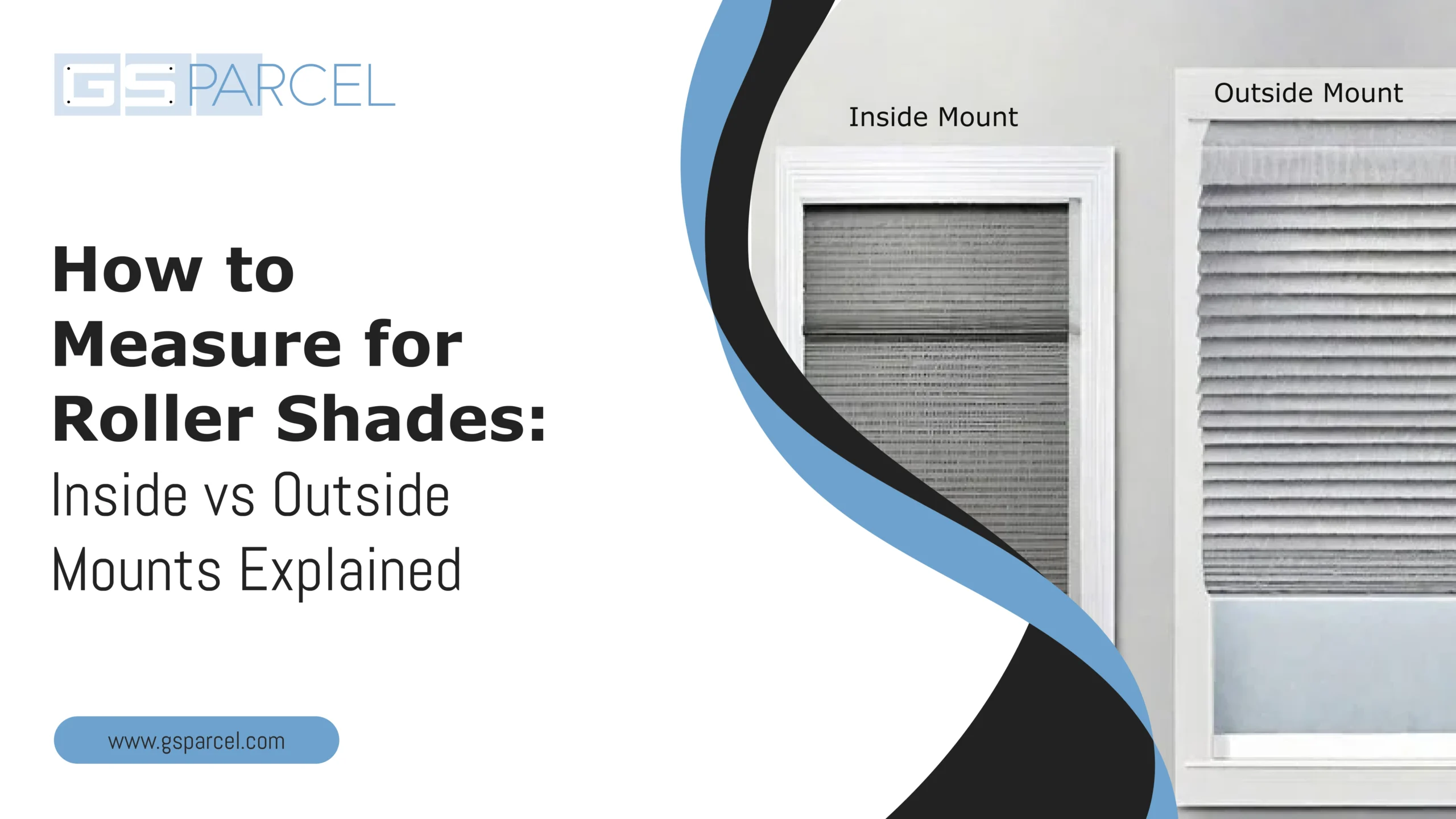When it comes to roller shades, the fit is everything. A perfectly measured shade makes your entire space look sleek, and also enhances privacy, reduces glare, while lowering energy costs. On the other hand, a poorly measured shade can leave light gaps, cause uneven operation, or worse, waste your investment altogether.
For commercial buildings such as offices, schools, and hospitals, improper measurement can interfere with automation systems, create compliance issues, and result in costly rework. Meanwhile, for multi-family residential properties, even minor errors multiply across dozens of units, leading to tenant dissatisfaction and higher maintenance costs.
In this blog, we’ll break down the two main installation styles: inside mounts, which deliver a clean, modern look, and outside mounts, which offer broader coverage and flexibility.
And while these steps will help you understand the process, large-scale or code-sensitive projects demand expertise. With GS Parcel’s certified specialists, every measurement is precise, every installation is compliant, and every shade performs precisely as it should, from day one.
What You’ll Need Before Measuring
If you’re curious about how roller shade measurements are taken, here are the basic tools professionals use on-site:
- Steel Measuring Tape – For the most accurate readings (never use fabric tape).
- Step Ladder – Especially important for tall windows in offices, lobbies, or apartment complexes.
- Pencil & Notepad (or Digital Worksheet) – Always record measurements in Width x Height (W x H) format.
- Level – To check for uneven frames or walls.
Pro Tip: No two windows are alike, even in the same building. Always measure each one individually.
Pre-Measurement Considerations
Before deciding on an inside or outside mount, ask these important questions:
- Depth of Frame: Is there enough recess for an inside mount?
- Desired Aesthetic: Do you want a minimal, flush look (inside mount) or full coverage with maximum light control (outside mount)?
- Obstructions: Handles, cranks, or uneven surfaces can affect measurements.
- Usage & Compliance: In schools, hospitals, or apartments, blackout or privacy shades may require an outside mount for proper coverage.
Why Professionals Are Needed: Small errors, like rounding to the nearest half inch or missing a frame obstruction, can mean hundreds (or even thousands) of dollars in wasted material on multi-unit projects. That’s why GS Parcel provides certified assessments instead of relying on guesswork.
Inside Mount Roller Shades

What Is an Inside Mount?
Inside-mount roller shades are installed neatly within the window frame. This creates a sleek, minimalist look that highlights the window’s architectural features. They’re popular in corporate offices, high-end lobbies, and modern residential complexes where aesthetics are as important as functionality.
How to Measure for Inside Mount Shades
- Check Window Depth
- Measure from the front of the frame to the glass.
- Ensure the recess meets the minimum depth requirement for the shade type.
- Shallow frames may not support an inside mount.
- Measure the Width
- Measure across the inside of the frame at the top, middle, and bottom.
- Record the narrowest measurement; this ensures the shade fits snugly.
- Measure the Height
- Measure inside height at the left, center, and right.
- Record the tallest measurement; this ensures the shade fully covers the window.
- Check for Obstructions
- Take note of any cranks, handles, or tiles that could interfere with the mounting or operation of the device.
Pro Tip: Submit your precise window opening size (don’t make your own deductions). Factories automatically account for clearance when producing shades.
When to Choose Inside Mount
- Corporate Offices: Clean lines that match modern interiors and save wall space.
- Libraries & Schools: Minimal hardware exposure, keeping spaces distraction-free.
- Homes & Residential Complexes: Enhance window trim in apartments, condos, or luxury rental units.
Inside mounts may leave small gaps in the light on the sides. For blackout needs (e.g., hospital rooms or bedrooms in apartments), an outside mount may be a better fit.
Outside Mount Roller Shades

What Is an Outside Mount?
Outside mount roller shades are installed above or around the window frame, covering the entire opening and often extending beyond it. This approach offers maximum coverage and flexibility, making it ideal for spaces where privacy, blackout capability, or irregular window structures are concerns. You’ll often see outside mounts in hospitals, schools, residential complexes, and large offices where performance matters more than preserving trim lines.
How to Measure for Outside Mount Shades
- Check the Mounting Surface
- Make sure there’s enough flat wall space or window trim to secure brackets.
- Measure the Width
- Measure the window’s width.
- Add 2–3 inches on each side for full coverage and to block light gaps.
- Measure the Height
- If there’s a windowsill, measure from the sill to 3 inches above the top of the frame (to allow for brackets).
- If there’s no sill, extend the measurement 2 inches below the opening for better coverage.
- Account for Obstructions
- Check for trim, vents, or light switches that may interfere with mounting.
Pro Tip: For blackout shades in hospitals or apartment bedrooms, outside mounts are preferred; they virtually eliminate light leaks.
When to Choose Outside Mount
- Healthcare Spaces: Blackout coverage for patient rooms and privacy-sensitive areas.
- Schools & Universities: Reliable glare control in classrooms with shallow or uneven window frames.
- Residential Apartments: Adds privacy and ensures coverage in units with inconsistent window depths.
- Corporate Offices: Hides imperfections in older windows while ensuring consistent aesthetics across large spaces.
While outside mounts deliver superior coverage, they may cover decorative trim or look bulkier compared to inside mounts. This is why professional measuring is essential to balance function and appearance.
Inside vs Outside Mount: Which One Should You Choose?
Both mounting styles are effective, but the right choice depends on your specific space, goals, and window conditions. Here’s a quick comparison:
| Factor | Inside Mount | Outside Mount |
| Look | Sleek, minimal, highlights window trim | Bold, full coverage hides imperfections |
| Light Control | May leave small side gaps | Blocks gaps for maximum privacy and blackout |
| Window Depth | Requires sufficient recess | Works even with shallow or uneven frames |
| Best For | Corporate offices, libraries, luxury apartments | Hospitals, schools, multi-family units, blackout needs |
Key Takeaways
- Choose Inside Mount if you want a modern, streamlined look and your windows have enough depth. Great for offices, libraries, or upscale apartments where aesthetics come first.
- Choose Outside Mount if you need blackout performance, maximum coverage, or you’re dealing with shallow/uneven frames. Perfect for hospitals, schools, and multi-family housing where privacy and light control are top priorities.
Pro Insight: Many commercial projects use a mix of both depending on room type, for example, inside mounts in public-facing lobbies and outside mounts in patient rooms or bedrooms.
Step-by-Step: How to Measure Roller Shades
Even the most minor error, sometimes just a ¼ inch, can cause gaps, crooked installation, or wasted material. Here’s how inside and outside mount measurements are taken:
Inside Mount
Measure Window Depth
- From the front edge of the frame to the glass.
- Confirm the depth meets the manufacturer’s minimum requirement.
Measure the Width
- Take three measurements: top, middle, and bottom.
- Record the narrowest width.
Measure the Height
- Take three measurements: left, center, and right.
- Record the tallest height.
Check for Obstructions
- Handles, cranks, or tiles may affect installation.
- Note these before ordering.
Tip: Always record dimensions as Width x Height (W x H). Submit exact numbers; factories make their own adjustments.
Outside Mount
Confirm Mounting Surface
- Ensure there’s enough flat wall or trim space above/around the window.
Measure the Width
- Measure across the window opening.
- Add 2–3 inches on each side for better coverage and light control.
Measure the Height
- With a sill: measure from the sill to 3 inches above the frame.
- Without a sill: measure 2 inches below the opening to 3 inches above the frame.
Check for Interference
- Consider the trim, vents, or switches that may block the installation.
Tip: For blackout or privacy-critical spaces (e.g., hospitals, classrooms, or bedrooms in multi-family units), outside mounts are typically the best option.
Why Hire Professionals?
While these steps seem straightforward, the reality is more complex in commercial and multi-unit settings. Frames are rarely identical, walls may be uneven, and ADA/fire code compliance must be considered. GS Parcel’s specialists use precision tools and provide site-wide measurements, ensuring every window is compliant, functional, and aesthetically consistent.
Standard Measurement Mistakes (and Why Pros Avoid Them)
Measuring roller shades may seem simple, but in practice, minor errors can create significant problems, especially in large buildings or multi-unit properties. Here are the most frequent mistakes we see:
- Mixing Up Width and Height: Submitting dimensions as height × width instead of width × height leads to incorrect orders and costly returns.
- Rounding Measurements: Measurements must be recorded to the nearest ⅛ inch. Rounding to the nearest half inch or inch creates gaps that compromise light control.
- Ignoring Frame Depth: Many windows lack sufficient recess for an inside mount, yet orders are still placed anyway. The result? Shades that don’t fit, or brackets sticking out awkwardly.
- Assuming Windows Are Identical: Even in new construction, no two windows are identical. Skipping individual measurements results in mismatched shades across a building.
- Forgetting Obstructions: Handles, cranks, tiles, or vents often block shades if not accounted for during measuring.
- Overlooking Compliance: In commercial and multi-family spaces, DIY measuring often ignores ADA and fire safety codes, posing a risk of failing inspections.
The Real Cost of Mistakes
Each of these errors leads to the same outcome: wasted product, higher costs, and unnecessary project delays. In commercial projects, these mistakes multiply, resulting in tenant complaints, failed inspections, and expensive rework.
That’s why GS Parcel emphasizes professional measurement. Our certified team ensures every window is accounted for, every opening meets code, and every shade is built to last.
GS Parcel’s Professional Measuring & Installation Process
Installing roller shades, especially across offices, hospitals, schools, or residential complexes, isn’t just about “hanging shades.” It’s about ensuring every unit works seamlessly, complies with building codes, and stands the test of daily use. Here’s how GS Parcel delivers:
Step 1: Free Site Assessment
Our specialists visit your property to evaluate window layouts, frame conditions, and daylight patterns. This helps us determine whether an inside or outside mount is best for each opening.
Step 2: Precise Measurement & Recommendation
Using professional-grade tools, we measure every window individually to the nearest ⅛ inch, taking into account depth, obstructions, and compliance factors. You’ll receive tailored recommendations, whether it’s blackout shades for patient rooms or light-filtering systems for office lobbies.
Step 3: Seamless Installation
Our certified in-house team (no third-party crews) handles the installation from start to finish. Brackets, hardware, and automation systems are integrated cleanly into your building’s architecture.
Step 4: Post-Install Compliance Check
We don’t just walk away after installation. Each system is tested for smooth operation, safety, and energy efficiency. For commercial settings, we also verify compliance with ADA, fire safety, and automation standards.
In commercial and multi-family environments, professional installation isn’t a luxury; it’s a necessity. With GS Parcel, you gain the assurance that every shade is measured right, installed right, and compliant with building standards.
Get Professional Window Roller Shades Installation with GS Parcel

Understanding the steps of roller shade installation is valuable. However, attempting it yourself risks budget overruns, compliance failures, and operational inefficiencies, issues that no facility manager or property supervisor can afford.
At GS Parcel, we combine UL-certified products, expert in-house installation, and compliance-driven processes to deliver roller shade solutions that excel in every category: aesthetics, efficiency, and safety.
Whether you’re managing a corporate office, outfitting a hospital wing, upgrading a university library, or enhancing a multi-family residential community, our specialists ensure every project is completed right the first time.
Ready to install roller shades like a true pro? Schedule your site assessment today.
